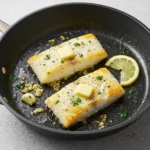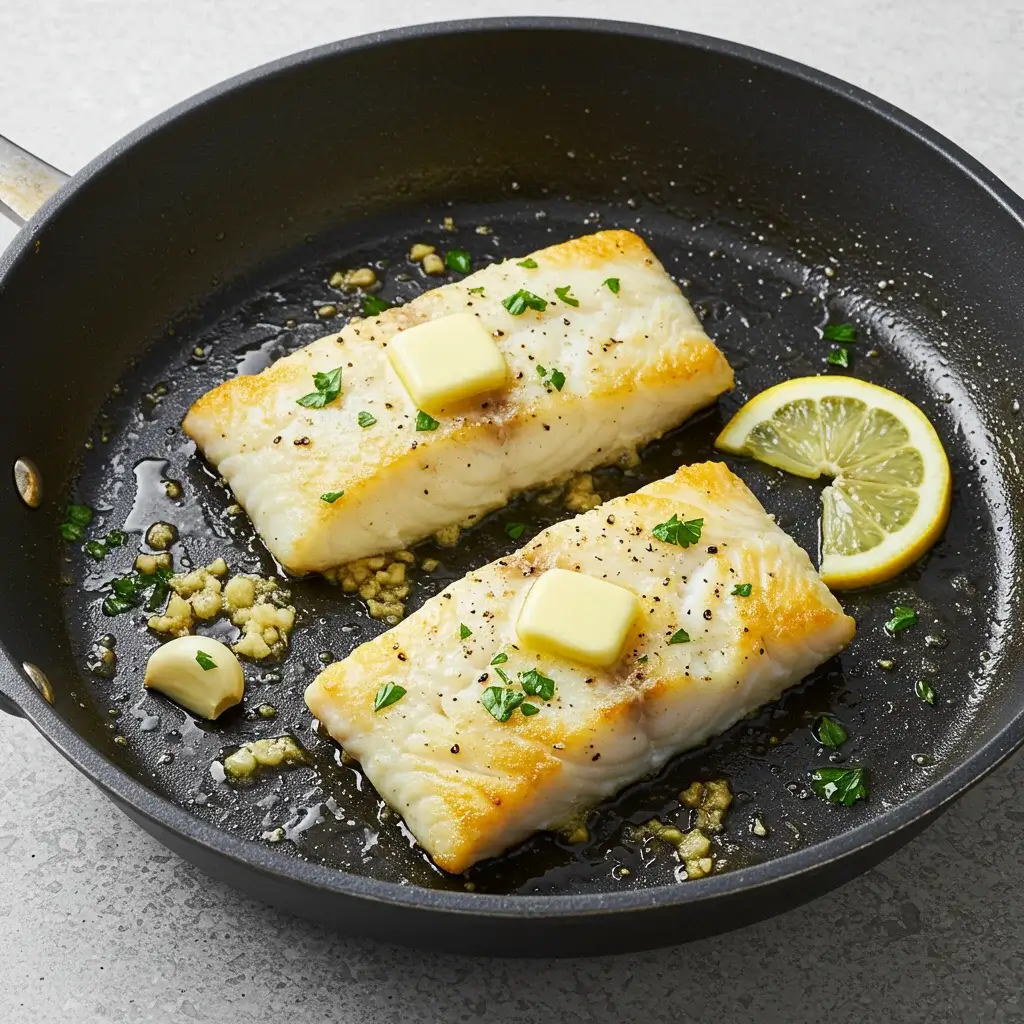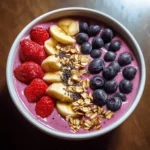Introduction
Welcome to the world of delightful seafood cooking with our Buttered Cod Skillet recipe. If you’re on the hunt for a dish that’s both delicious and easy to prepare, look no further. Cod is a mild-flavored fish that pairs beautifully with the rich taste of butter, the aromatic hint of garlic, and the zesty punch of lemon. This dish is perfect for a quick weeknight dinner or an impressive weekend meal. Let’s dive into this simple yet flavorful recipe that will surely become a staple in your culinary repertoire.
Ingredients
To create this mouthwatering Buttered Cod Skillet, you’ll need the following ingredients:
- 2 cod fillets
- 4 tbsp butter
- 2 garlic cloves, minced
- 1 lemon, juiced
- Salt and pepper, to taste
- Fresh parsley, chopped (for garnish)
With just a few ingredients, you can create a dish that is not only healthy but also bursting with flavor. Now, let’s move on to the step-by-step instructions.
Instructions
Preparing the Buttered Cod Skillet is straightforward and quick. Follow these easy steps to achieve a perfectly cooked meal:
- Heat butter in a skillet
- Start by heating 2 tablespoons of butter in a skillet over medium heat. This will create the perfect base for your cod fillets.
- Sauté garlic
- Add the minced garlic to the skillet and sauté for about 1 minute until it becomes fragrant. Be careful not to burn the garlic as it can turn bitter.
- Season and cook the cod fillets
- Season the cod fillets with salt and pepper to taste. Place them gently in the skillet. Allow them to cook for approximately 4-5 minutes on each side until they achieve a golden brown crust.
- Add lemon and butter
- Squeeze the juice of one lemon over the cooked fillets. Add the remaining butter to the skillet and let it melt, creating a luscious sauce that complements the fish perfectly.
- Garnish and serve
- Finally, garnish the fish with fresh chopped parsley before serving. This adds a fresh, herbaceous note to the dish.
Nutrition Facts
Understanding the nutritional content of your meals is essential for maintaining a balanced diet. Here’s a breakdown of the nutrition facts per serving of Buttered Cod Skillet:
- Calories: 250
- Protein: 25g
- Fat: 15g
- Carbohydrates: 2g
With such nutritional benefits, this dish is not only delectable but also a healthy option for those watching their calorie intake.
How to Serve
The The Buttered Cod Skillet is not only a delectable dish on its own, but its versatility allows for a variety of serving options that can elevate your dining experience. Here are several delightful ways to serve this flavorful cod, ensuring a well-rounded and satisfying meal.
1. With Vegetables
Pairing the Buttered Cod with a medley of vegetables not only adds vibrant color to your plate but also enhances the nutritional value of the meal. Consider these options:
- Steamed Vegetables: Lightly steaming vegetables like asparagus, broccoli, or green beans preserves their crunch and bright flavor while providing a healthy side. The simplicity of steamed vegetables allows the rich butter and lemon sauce of the cod to shine through.
- Roasted Vegetables: Roasting vegetables such as carrots, bell peppers, or Brussels sprouts caramelizes their natural sugars, adding a layer of sweetness that contrasts beautifully with the savory cod. Toss the vegetables in olive oil, salt, and pepper before roasting to enhance their flavor.
- Sautéed Greens: Sautéing spinach or kale with garlic in olive oil creates a delicious and nutritious side dish. The slight bitterness of the greens pairs wonderfully with the buttery, zesty cod.
2. Over Rice or Quinoa
Serving the Buttered Cod over a bed of grains not only makes for a heartier meal but also allows for the delicious butter and lemon sauce to soak into the grains, enhancing their flavor. Here are a few options:
- White or Brown Rice: Classic white rice provides a neutral base that absorbs the sauce well, while brown rice adds a nutty flavor and is a great source of fiber. You can also infuse the rice with herbs or spices, such as a bay leaf or a clove of garlic, while cooking to add an extra layer of taste.
- Quinoa: Quinoa is an excellent gluten-free option packed with protein and has a pleasant, slightly nutty flavor. Cooking quinoa in vegetable or chicken broth instead of water can elevate its taste, making it a perfect backdrop for the cod.
- Cauliflower Rice: For a low-carb alternative, consider serving the cod over cauliflower rice. This light option is easy to prepare and takes on the flavors of the butter and lemon sauce beautifully.
3. With a Side Salad
A fresh side salad can provide a refreshing contrast to the richness of the Buttered Cod. Here are some salad ideas that complement the dish:
- Mixed Greens Salad: A simple salad of mixed greens—such as arugula, spinach, and romaine—dressed with a light vinaigrette balances the richness of the cod. Adding ingredients like sliced radishes, shredded carrots, or avocado can enhance texture and flavor.
- Mediterranean Salad: Incorporate ingredients like cherry tomatoes, cucumbers, red onion, olives, and feta cheese for a Mediterranean twist. A drizzle of olive oil and balsamic vinegar brings the salad together and pairs beautifully with the cod.
- Citrus Salad: A salad featuring segments of oranges or grapefruits, along with mixed greens and a light dressing, can brighten up the dish. The citrus notes echo the lemon in the Buttered Cod, creating a harmonious flavor profile.
Conclusion
No matter how you choose to serve the Buttered Cod Skillet, whether it be accompanied by vibrant vegetables, over a hearty grain, or alongside a refreshing salad, this dish is sure to impress your family and guests alike. Each serving suggestion offers a unique way to experience the delightful flavors of the cod while ensuring a balanced and nourishing meal. With its versatility and rich taste, the Buttered Cod Skillet is a perfect choice for weeknight dinners or special occasions. Enjoy the culinary creativity that comes with this dish as you explore different combinations and flavors!
Additional Tips
To enhance your cooking experience and ensure the best results, consider these additional tips:
Choose Fresh Cod
When it comes to seafood, the quality of your main ingredient can significantly influence the final dish. Fresh cod fillets are ideal for this recipe due to their firm texture and clean, mild flavor, which allows them to absorb seasonings and sauces beautifully. When selecting fresh cod, look for fillets that are translucent and glistening, with a mild ocean scent. The flesh should be bright white with no discoloration, and it should spring back when pressed lightly. If fresh cod is unavailable, high-quality frozen fillets can be a suitable alternative. Just ensure that they are fully thawed before cooking. To thaw frozen cod safely, place it in the refrigerator overnight or use the cold water method: seal the fillet in a plastic bag and submerge it in cold water for about an hour. Avoid using warm water, as it can lead to uneven thawing and compromise the texture of the fish.
Control the Heat
Heat control is pivotal in achieving the perfect sear on your cod. Start by preheating your skillet over medium heat. This allows for a consistent cooking temperature, crucial for preventing the butter from burning. If the heat is too high, the butter can quickly become brown and even burnt, imparting a bitter flavor that can overshadow the delicate taste of the cod. A medium heat ensures a balanced cooking process, allowing the fish to develop a beautifully browned crust while cooking through evenly. As a general rule, if you notice the butter beginning to smoke or turn dark, reduce the heat slightly. Additionally, consider using a combination of butter and oil, such as olive or canola oil. The oil raises the smoke point, allowing the butter to contribute its rich flavor without burning. This technique can help you achieve that perfect golden crust while maintaining the integrity of the fish.
Experiment with Herbs
While parsley is a classic and versatile herb that complements cod beautifully, don’t hesitate to get creative with your herb choices. Fresh herbs can elevate the dish, adding layers of flavor that can transform the entire meal. For a refreshing twist, consider using dill, which pairs exceptionally well with fish, imparting a subtle anise-like flavor that enhances the cod’s natural sweetness. Thyme is another excellent option; its earthy notes can provide depth and complexity to the dish, especially if you’re preparing a sauce alongside the cod. For a Mediterranean flair, try incorporating fresh basil or oregano, which can add a vibrant, aromatic touch.
If you’re feeling adventurous, consider creating a herb blend to sprinkle over the cod before cooking. A combination of chopped fresh herbs like cilantro, chives, or tarragon can introduce exciting flavor profiles. Additionally, don’t overlook dried herbs—though not as vibrant as fresh, they can still provide a concentrated flavor. Just remember to use them sparingly, as dried herbs are more potent than their fresh counterparts. For an extra burst of freshness, you can also finish the dish with a squeeze of lemon juice or a sprinkle of zest, which brightens the flavors and adds a delightful acidity that balances the richness of the butter.
By keeping these tips in mind, you’ll be well on your way to preparing a delicious cod dish that not only impresses but also enhances your overall cooking experience. Enjoy the process, and don’t be afraid to make each recipe your own!
FAQs
Q1: Can I use a different type of fish?
Yes, you can certainly substitute cod with other white fish varieties such as haddock, halibut, or tilapia, each bringing its unique texture and flavor profile to the dish. Haddock, for example, is similar in flavor to cod but tends to have a slightly sweeter taste and a firmer texture, making it an excellent alternative in recipes that require poaching or grilling. Halibut, known for its meaty texture, is another great choice; it holds up well to various cooking methods, including roasting and frying, and has a mild taste that pairs well with many seasonings. Tilapia, often more readily available and typically less expensive, offers a delicate flavor that works wonderfully in dishes with vibrant sauces or marinades.
When substituting fish, it’s important to consider the cooking times, as different species have varying thicknesses and moisture content. For example, halibut may require a slightly longer cooking time due to its density, while tilapia might cook faster because of its thinner fillets. To ensure the best results, monitor the fish closely as it cooks, and utilize a food thermometer if necessary; the ideal internal temperature for cooked fish is 145°F (63°C).
Q2: How do I know when the cod is cooked?
Determining the doneness of cod is crucial for achieving the best texture and flavor. Cod is considered properly cooked when it flakes easily with a fork and appears opaque throughout, indicating that the protein has been properly denatured by heat. The flesh should transition from a translucent appearance to a solid white, signaling it’s ready to eat.
To test for doneness, gently press the fish with a fork at its thickest point. If the flesh separates easily into flakes, it is done. Conversely, overcooking cod can lead to a dry, unappetizing texture, so it’s advisable to remove it from heat just before it reaches the flaking stage, as it will continue to cook from residual heat even after being removed from the pan. If using a food thermometer, aim for an internal temperature of 145°F (63°C) to ensure safety and optimal texture.
Q3: Can I add additional spices or flavors?
Absolutely! The versatility of cod allows for a wide range of spices and flavorings to enhance its natural taste. You can experiment with a variety of seasonings to suit your palate. For instance, adding smoked paprika can impart a delightful smoky flavor that complements the mildness of the fish, while a sprinkle of cayenne pepper can introduce a pleasant heat that elevates the dish.
Herbs such as dill, parsley, or cilantro can also be used to freshen up the flavor profile. A squeeze of lemon or lime juice can brighten the dish and provide a refreshing contrast to the fish’s richness. If you’re in the mood for something more adventurous, consider marinating the cod in a blend of soy sauce, garlic, and ginger for an Asian-inspired twist, or use a spicy harissa paste for a North African flair. The key is to balance the flavors and not overwhelm the delicate taste of the fish.
Q4: Is this dish freezer-friendly?
While enjoying cod fresh is always the best option for flavor and texture, you can indeed freeze cooked cod for later enjoyment. To preserve its quality, allow the fish to cool completely at room temperature before transferring it to an airtight container or freezer-safe bag. It’s essential to remove as much air as possible from the bag to prevent freezer burn, which can affect both taste and texture.
When properly stored, cooked cod can last in the freezer for up to two months. For reheating, it’s best to thaw the fish in the refrigerator overnight before gently reheating it to maintain its moisture. Avoid reheating it in the microwave, as this can lead to uneven cooking and a rubbery texture. Instead, opt for the oven or stovetop, cooking it slowly over low heat to ensure it remains tender and flavorful. If you find yourself with leftover cod, consider incorporating it into a fish chowder or a seafood pasta dish—both are excellent ways to utilize frozen fish while still keeping meals exciting and delicious.
Conclusion
The Buttered Cod Skillet is a testament to how simple ingredients can create a dish that is both elegant and satisfying. With its quick preparation time and delightful flavor, it’s an excellent choice for anyone seeking a healthy and tasty meal without spending hours in the kitchen. Whether you’re cooking for yourself, your family, or guests, this recipe is sure to be a hit. Enjoy the rich flavors and share this delightful dish with those you love. Happy cooking!
Print
Buttered Cod Skillet Recipe
Ingredients
- 2 cod fillets
- 4 tbsp butter
- 2 garlic cloves, minced
- 1 lemon, juiced
- Salt and pepper, to taste
- Fresh parsley, chopped (for garnish)
Instructions
- Heat butter in a skillet
- Start by heating 2 tablespoons of butter in a skillet over medium heat. This will create the perfect base for your cod fillets.
- Sauté garlic
- Add the minced garlic to the skillet and sauté for about 1 minute until it becomes fragrant. Be careful not to burn the garlic as it can turn bitter.
- Season and cook the cod fillets
- Season the cod fillets with salt and pepper to taste. Place them gently in the skillet. Allow them to cook for approximately 4-5 minutes on each side until they achieve a golden brown crust.
- Add lemon and butter
- Squeeze the juice of one lemon over the cooked fillets. Add the remaining butter to the skillet and let it melt, creating a luscious sauce that complements the fish perfectly.
- Garnish and serve
- Finally, garnish the fish with fresh chopped parsley before serving. This adds a fresh, herbaceous note to the dish.
Nutrition
- Serving Size: one normal portion
- Calories: 250
- Fat: 15g
- Carbohydrates: 2g
- Protein: 25g





